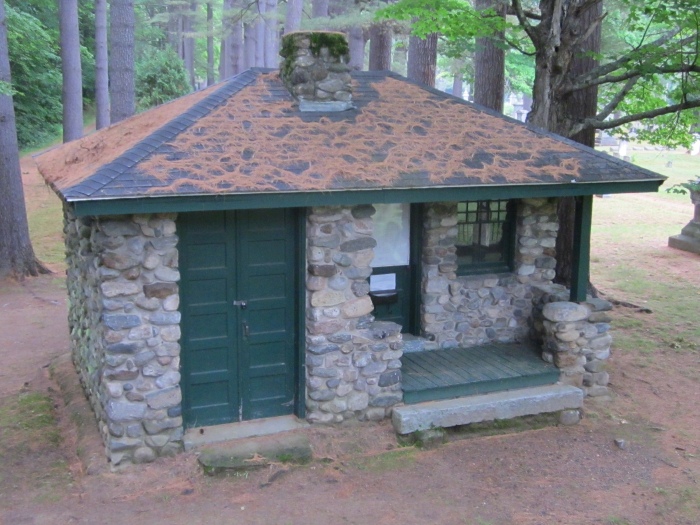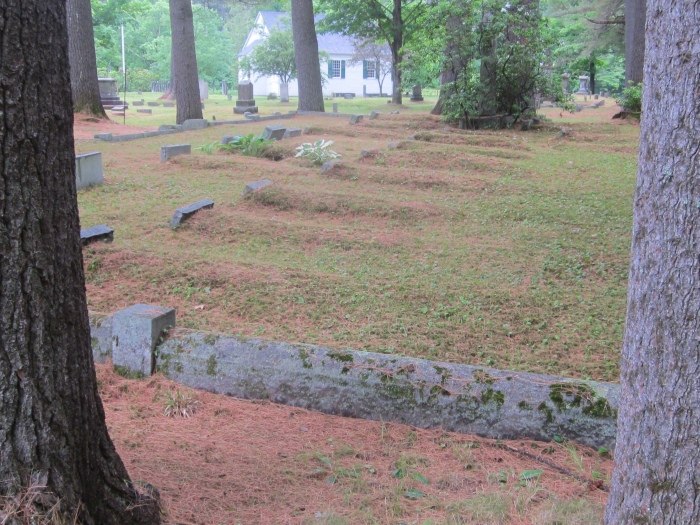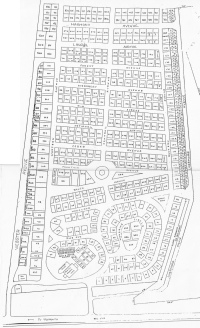History of the Trinity Church
Owner: Trinity Church Yard Cemetery Association
Age of Structure: Built in 1797
Builder/Designer: Unknown

The following (in italics) is quoted from A Guide to National Register Properties in the Lakes Region, Lakes Region Planning Commission, Meredith, NH, 1986, by David Ruell.
"Description: Trinity Church is a small, one story wooden church located in the Churchyard Cemetery. The gable roofed main block has a small, hip roofed vestibule on its west gable end and a small, shed roofed pulpit projection on its east gable end. All three sections are set on cut granite block foundations, sheathed with clapboards and trimmed with cornerboards, close verges and close lateral eaves with friezes. Plain trim and louvred shutters surround the windows, which, save for the one 6/6 sash window in the pulpit projection, have 12/12 sash. The vestibule has one window, while the main block is well lit by two windows in each gable end and three windows in each lateral facade. The church’s only entry is a plain framed four panel door in the south (side) façade of the vestibule.
The vestibule and the auditorium that occupies the main block both have wide board floors, wide board wainscoating beneath plaster walls, plain window and door frames, and plaster ceilings. The auditorium also has wall posts encased by plain boards, and a simple but deep moulded cornice. The auditorium is largely filled by box pews, two rows of slip pews in the center and larger box pews lining the walls. The pews, all raised above the main floor, are distinguished by paneled doors and partitions. In front of the pulpit, which is set in the eastern pulpit projection, is a low platform enclosed by a railing. The front of the pulpit, which has a projecting three-sided center and two wings, is ornamented by a moulded baseboard, two rows of panels divided by a moulded string course, and a deep moulded cornice. Steps lead up to the high floor of the pulpit, which is set in a paneled recess.
History: Samuel Livermore (1732-1803), a lawyer in Portsmouth and Londonderry, became Attorney General of the Province of New Hampshire in 1769. But, as the American Revolution approached in the winter of 1775, he moved north to his land holdings in the frontier town of Holderness. He quickly became the town’s most prominent citizen and largest landowner. Livermore soon cast his lot with the new government, becoming the state’s Attorney General in 1776, and later serving in the Continental Congress and as Chief Justice of the state. He was a major leader in the movement to ratify the U.S. Constitution, and, served, under that Constitution, as one of New Hampshire’s first Congressmen, and, then as a U.S. Senator, until ill-health forced his resignation.
Of Livermore’s Holderness buildings, only Trinity Church remains. Samuel Livermore was an Episcopalian and married the daughter of Portsmouth’s Episcopalian pastor. His adopted town of Holderness became one of the four New Hampshire communities which supported Episcopalian churches in the 18th century, probably due largely to his influence. Church services were at first conducted in Livermore’s large house. But, in 1797, Trinity Church was erected nearby on his land. Although no documents survive to describe the construction, there is general agreement that the Livermores bore most of the cost. Never conveyed to the Episcopalian parish or diocese, Trinity Church remained the property of the Livermore family until 1854, when Samuel’s grandson deeded it and the adjoining burying ground to the Churchyard Cemetery. By then, the Church was little used, and it has survived unaltered, appearing today virtually as it did in 1797 [with the exception of minor gable end roof extensions to control water runoff and moisture].
Trinity Church is a modest late 18th century vernacular building, with little architectural embellishment beyond the paneled woodwork of the pews and pulpit. It is, however, unique as the only 18th century New Hampshire church that retains its original appearance. In the 17th and 18th centuries, most New Hampshire religious buildings were meetinghouses, with the entry in one long lateral façade and the pulpit on the opposite wall. Only the Episcopalian churches adopted what later became the standard plan, with the entry in one gable end and the pulpit at the opposite end of the building. (The only other surviving 18th century New Hampshire religious building to use the “church plan” is Union Episcopal Church in Claremont, an altered but still attractive church.) Trinity Church is therefore far more significant in the architectural history of the state than its modest size and simple details would suggest."
Trinity Church is listed on the Department of Interior's National Register of Historic Places. The following images show views inside the church and a chart of the original pew assignments.



History of the Cemetery and Other Structures
As noted above, the Trinity Church Yard Cemetery Association has provided control and management oversight of the Cemetery through its Board of Trustees continuously from June, 1854 when Arthur Livermore, Jr. deeded the Church and burying ground to the Association for one dollar. This likely included the adjacent Tool House and Tomb described below.
Holderness School (www.holderness.org) acquired the Livermore homestead for its use in 1879. The Holderness School for Boys opened with a sermon in the Trinity Church on September 11 that year. The School utilized the Church as its chapel until it built its own (the Chapel of the Holy Cross) on the campus in 1884. However it continues to hold an annual service at the Trinity Church each spring. Holderness School owns all the land surrounding the Cemetery, with the exception of the south boundary owned by the State of New Hampshire- Route 175 and the right-of-way (ROW). State law prohibits any burials within 50 feet of a state ROW. Fortunately, the entrance to Trinity Cemetery is set back 80 feet from Route 175.
There are no known records of the date of construction of the front fencing or gates leading into the Cemetery. The main gate is a 12 foot wide swinging pair of wrought iron gates mounted on 7 foot tall granite posts.

Single gates on each side of the main are 5 feet wide with 4.5 foot granite posts on the side. The entire fence is made of one tier of granite blocks 7 feet long. At each intersection there is a 1 foot high granite post which supports a 2.5 foot high wrought iron fence post and finial cap. Connecting the fence posts and running along the top of the granite blocks are an 8 foot length of wrought iron rail 2 feet tall with a simple design as noted below. This exquisite fence runs east of the main gate 202 feet to a granite end post 4.5 feet high.

West of the main gate and parallel with Route 175, the wrought iron fence extends 168 feet to the Tomb and 199 feet to the west gate. This gate entrance is also 12 feet wide with 5 foot high granite posts similar in construction to the main gate. The Tomb entrance faces south towards Route 175 and is 18 feet wide and 18 feet deep and 12 feet high. It is a brick-lined vault covered with earth and grassed slopes with two vent pipes. It is still utilized to store the deceased during winter months and prior to Cemetery burial. Given its location and historical need, it is likely this structure was constructed soon after the Church was built in 1797.

The Tool House is a stone building with the dimensions of 14 X 20 feet situated behind the Tomb and to the west of the Church. The stones are rounded streambed stones and not angular. Originally the Tool House contained a wood stove for heat which was vented to a central chimney. There are two levels, the lower being the side entrance with two hinged wooden doors facing east. This floor is poured concrete and used to store barrels, tools, the fountain cherub, etc. There is an old storage cabinet for miscellaneous items and two fixed 20 pane windows each on the west side set high under the eaves. A step up to the floor of the main room from the concrete floor is through a small wooden door. The main room floor is wood. There are two windows set in the stone walls, of 20/2 sashes! The main entrance door is paneled wood and is set back on a small entrance porch. All wood is painted a dark green. A large map of Cemetery lots and owners is posted on this door, as well as a copy of Association Rules. The roof is covered with asphalt shingles with a one foot overhang. The age of this building is not known but it may have been constructed contemporaneously with the Tomb and Church.

The Cemetery grounds were laid out with expansion in mind. The Cemetery is rectangular in shape with the narrow side along Route 175. All access roads are marked with iron poles and signs on top. The main entrance leads to Trinity Church on the left (east) and on to Livermore Avenue; or to Central Avenue which divides the original Cemetery; or to the east along Eastern Avenue. Entrance through the west gate leads to Western Avenue which largely forms the west boundary until it joins Livermore Avenue. Other avenues branch off Central Avenue, including Pine, Woodland, Balch, Fountain, Cedar, National, Elm, Evergreen, Forest, Laurel, and Harmony. There are approximately 600 family burial lots within this Cemetery. Older lots provided space for 10 full burials and were often provided with access alleys between lots. Over time lot size has been reduced to save valuable space and lots abutted each other without alleys. Newer lots located on the eastern side of the Cemetery are sized for four full burials (up to four cremations are allowed in each grave). With the trend toward cremations, future lot layout will likely reflect reduced lot size.
As is typical with cemetery layouts of this era, a centrally located fountain lies at the intersection of Fountain Avenue and Central Avenue. This octagonal structure is 13 feet across and approximately 2 feet deep, made of concrete. In the center is a gold-painted cherub of unknown age spouting a fine stream of spring water. Overflow is through a drain to the surrounding ground. The Cemetery grounds are serviced by water via an underground network of pipes and laterals with the water source on Heritage Hill approximately 1/2 mile upgradient of the Cemetery.

The Cemetery near the Church is the oldest section, and is the basis for the moniker "church yard cemetery". The original landowners and Church builder were the Livermores who are buried just outside the Church to the west. Instead of straight roads from the main gate, the older graves are largely located in circular paths.
Many of the older cemetery lots had granite surrounds with raised beds. Others had just the raised beds. The Balch family lot along Livermore Avenue has granite surrounds, steps, and is unique in that most burials left the extra soil above ground

An inventory of graves and inscriptions conducted by Norton R. Bagley and Michael C. Vacca in 1985 documented 1639 individuals buried at Trinity Cemetery as of that time. From their work:
The largest cemetery in Holderness, this yard is beautifully kept. Some of the early stones have been reset and apparently are not in their original order since members of the same family are separated by other stones. There are a few field stones which seem to mark graves. Scattered throughout the cemetery are apparently vacant lots which, from their contours, seem to contain graves, but without markers….We have taken the liberty, well aware of the peril, of indicating as a wife, a female inscription where the stone is next to the husband's and where the dates are reasonably close. We apologize for any erroneous marriages!
There is an alphabetical listing of lot owners provided here. This is an ongoing effort and currently incomplete. It does not contain a listing of all interred but provides a means of cross–referencing owners to lot numbers as shown on the Cemetery map provided. Another resource lies within findagrave.com which currently contains a listing of over 550 names and photos of grave markers within Trinity Cemetery. Of particular note is the grave memorial for Harl Pease, Jr., a World War II Congressional Medal of Honor recipient born in Plymouth, New Hampshire (see http://www.findagrave.com/cgi-bin/fg.cgi?page=gr&GRid=8096123).
The Cemetery is beautifully landscaped with majestic 150+ year old white pine and sugar maples. Mindful of the age of these giants, the Association has embarked on a tree and shrub planting effort to provide seasonal color, maintain shade, and preserve the historic character of the Cemetery as the old trees slowly die and are removed.
Currently the Town of Holderness tax maps indicate this property contains 12.4 acres. Additional land may be available as a result of land swaps with Holderness School.
